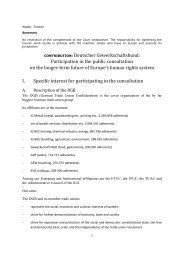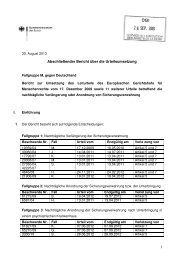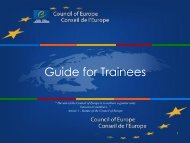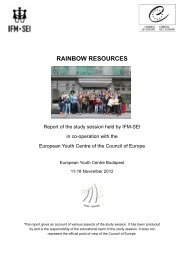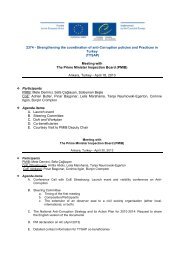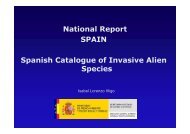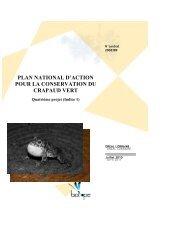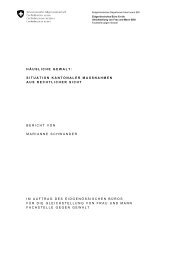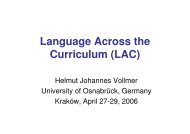Money laundering through money remittance ... - Council of Europe
Money laundering through money remittance ... - Council of Europe
Money laundering through money remittance ... - Council of Europe
You also want an ePaper? Increase the reach of your titles
YUMPU automatically turns print PDFs into web optimized ePapers that Google loves.
Example 6 – Ownership <strong>of</strong> bureaux de change<br />
<strong>Money</strong> Laundering <strong>through</strong> <strong>Money</strong> Remittance and Currency Exchange Providers - 2010 <br />
A suspicious transaction report was received in the FIU. The report revealed that one person owned<br />
more than 15 businesses, and three <strong>of</strong> them were bureaux de change. The characteristics <strong>of</strong> the<br />
operations <strong>of</strong> the bureaux the change were the following:<br />
- The bureaux de change mainly change <strong>Europe</strong>an currencies, especially one.<br />
- The amounts changed are higher than usual.<br />
- There is no link between the amount <strong>of</strong> <strong>money</strong> changed and holiday periods.<br />
Police investigations revealed that not so many people enter into the bureaux de change and, from<br />
time to time, a person made contact with the owner <strong>of</strong> the bureaux the change and gave him a bag<br />
with <strong>money</strong> in foreign currency. One or two days later the owner <strong>of</strong> the bureaux de change gave back<br />
the <strong>money</strong> in the local currency to that man. It was also established that the <strong>money</strong> laundered came<br />
from drug trafficking.<br />
Source: Spain.<br />
77. The following indicators could be relevant in this context:<br />
Reluctance by the MR provider to provide information about customers‟ identification to<br />
relevant stakeholders;<br />
Use <strong>of</strong> false identification and fictitious names for customers;<br />
Frequent transactions or purchases <strong>of</strong> negotiable instruments slightly under the legal<br />
threshold amount in order to avoid filing a STR/CTR;<br />
Turnover <strong>of</strong> the MR provider exceeds to a large extent the cash-flows <strong>of</strong> other<br />
comparable businesses;<br />
Suspicious connections <strong>of</strong> the MR provider owner; and<br />
Suspicious transactions performed on the bank accounts <strong>of</strong> the MR provider or its owner.<br />
78. To deal with these vulnerabilities, most <strong>of</strong> the jurisdictions contributing information to this<br />
study require a „fit and proper‟ test to be applied to the owners and managers <strong>of</strong> the MR/CE service<br />
providers at least as a component <strong>of</strong> a licensing/registration procedure. There are exceptions, as in<br />
Chile; Georgia; Hong Kong, China; Japan; and Mexico, where no specific requirements are applied for<br />
owners and managers <strong>of</strong> bureau de change. The most prevalent „fit and proper‟ checks include<br />
determining that (1) the person has not been convicted for a criminal <strong>of</strong>fence, (2) the person has not<br />
been denied the right to hold certain positions/undertake certain activities; and (3) the person has no<br />
outstanding tax obligations and not been in bankruptcy for a defined number <strong>of</strong> years.<br />
2.3 Most common predicate <strong>of</strong>fences identified<br />
79. A number <strong>of</strong> law enforcement investigations have revealed that MR service providers are<br />
frequently used as a vehicle for <strong>laundering</strong> illicit proceeds. Laundered proceeds in such cases come<br />
primarily from drug trafficking, fraud (mainly IT-fraud like phishing); economic crimes (document<br />
forgery, malfeasance, tax evasion, etc); trafficking in human beings, smuggling <strong>of</strong> human beings; theft<br />
(credit card fraud, currency theft, etc) and smuggling (e.g., tobacco, alcohol, arms). Previous FATF<br />
typologies have identified that ML schemes involving these types <strong>of</strong> crimes <strong>of</strong>ten appear to avoid<br />
using the banking system, and that systems for <strong>money</strong> <strong>remittance</strong> 22 are therefore sometimes<br />
specifically preferred as <strong>of</strong>fering less risk <strong>of</strong> detection.<br />
22 FATF (2005), pp 73.<br />
© 2011 MONEYVAL and FATF/OECD - 29



